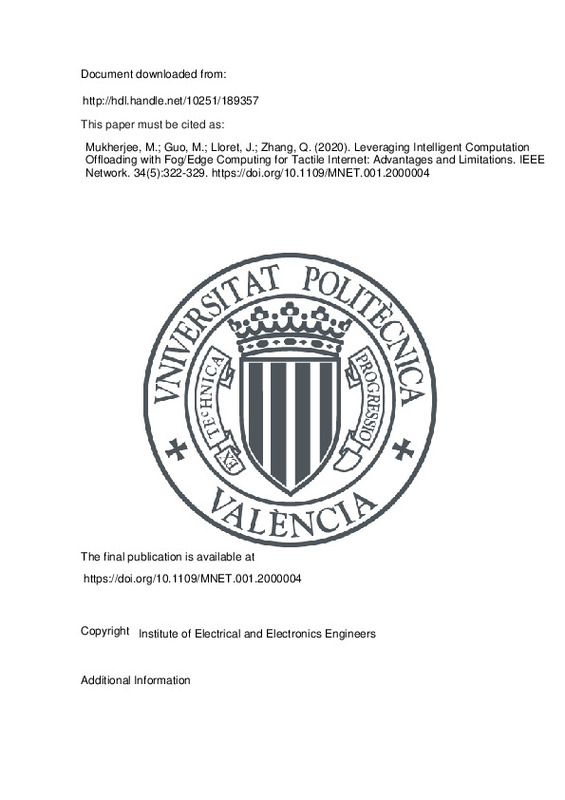JavaScript is disabled for your browser. Some features of this site may not work without it.
Buscar en RiuNet
Listar
Mi cuenta
Estadísticas
Ayuda RiuNet
Admin. UPV
Leveraging Intelligent Computation Offloading with Fog/Edge Computing for Tactile Internet: Advantages and Limitations
Mostrar el registro sencillo del ítem
Ficheros en el ítem
| dc.contributor.author | Mukherjee, Mithun
|
es_ES |
| dc.contributor.author | Guo, Mian
|
es_ES |
| dc.contributor.author | Lloret, Jaime
|
es_ES |
| dc.contributor.author | Zhang, Qi
|
es_ES |
| dc.date.accessioned | 2022-11-07T16:34:35Z | |
| dc.date.available | 2022-11-07T16:34:35Z | |
| dc.date.issued | 2020-10 | es_ES |
| dc.identifier.issn | 0890-8044 | es_ES |
| dc.identifier.uri | http://hdl.handle.net/10251/189357 | |
| dc.description.abstract | [EN] With the recent advancement in wireless communication and networks, we are at the doorstep of the Tactile Internet. The Tactile Internet aims to enable the skill delivery and thereafter democratize the specialized skills for many emerging applications (e.g., remote medical, industrial machinery, remote robotics, autonomous driving). In this article, we start with the motivation of applying intelligent edge computing for computation offloading in the Tactile Internet. Afterward, we outline the main research challenges to leverage edge intelligence at the master, network, and controlled domain of the Tactile Internet. The key research challenges in the Tactile Internet lie in its stringent requirements such as ultra-low latency, ultra-high reliability, and almost zero service outage. We also discuss major entities in intelligent edge computing and their role in the Tactile Internet. Finally, several potential research challenges in edge intelligence for the Tactile Internet are highlighted. | es_ES |
| dc.description.sponsorship | This work was supported in part by the National Natural Science Foundation of China under Grant 61901128, and Agile Edge Intelligence for Delay Sensitive IoT (AgilE-IoT) project (Grant No. 9131-00119B) of Independent Research Fund Denmark (DFF). | es_ES |
| dc.language | Inglés | es_ES |
| dc.publisher | Institute of Electrical and Electronics Engineers | es_ES |
| dc.relation.ispartof | IEEE Network | es_ES |
| dc.rights | Reserva de todos los derechos | es_ES |
| dc.subject | Internet | es_ES |
| dc.subject | Haptic interfaces | es_ES |
| dc.subject | Reliability | es_ES |
| dc.subject | Task analysis | es_ES |
| dc.subject | Robot sensing systems | es_ES |
| dc.subject | Wireless communication | es_ES |
| dc.title | Leveraging Intelligent Computation Offloading with Fog/Edge Computing for Tactile Internet: Advantages and Limitations | es_ES |
| dc.type | Artículo | es_ES |
| dc.identifier.doi | 10.1109/MNET.001.2000004 | es_ES |
| dc.relation.projectID | info:eu-repo/grantAgreement/NSFC//61901128 | |
| dc.rights.accessRights | Abierto | es_ES |
| dc.description.bibliographicCitation | Mukherjee, M.; Guo, M.; Lloret, J.; Zhang, Q. (2020). Leveraging Intelligent Computation Offloading with Fog/Edge Computing for Tactile Internet: Advantages and Limitations. IEEE Network. 34(5):322-329. https://doi.org/10.1109/MNET.001.2000004 | es_ES |
| dc.description.accrualMethod | S | es_ES |
| dc.relation.publisherversion | https://doi.org/10.1109/MNET.001.2000004 | es_ES |
| dc.description.upvformatpinicio | 322 | es_ES |
| dc.description.upvformatpfin | 329 | es_ES |
| dc.type.version | info:eu-repo/semantics/publishedVersion | es_ES |
| dc.description.volume | 34 | es_ES |
| dc.description.issue | 5 | es_ES |
| dc.relation.pasarela | S\473177 | es_ES |
| dc.contributor.funder | National Natural Science Foundation of China |







![[Cerrado]](/themes/UPV/images/candado.png)

